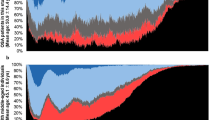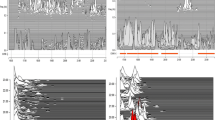Abstract
Introduction
Recently, we have developed a simple method that uses two electro-oculography (EOG) electrodes for the automatic scoring of sleep-wake in normal subjects. In this study, we investigated the usefulness of this method on 284 consecutive patients referred for a suspicion of sleep apnea who underwent a polysomnography (PSG).
Method
We applied the AASM 2007 scoring rules. A simple automatic sleep-wake classification algorithm based on 18–45 Hz beta power was applied to the calculated bipolar EOG channel and was compared to standard polysomnography. Epoch by epoch agreement was evaluated.
Result
Eighteen patients were excluded due to poor EOG quality. One hundred fifty-eight males and 108 females were studied, their mean age was 48 (range 17–89) years, apnea-hypopnea index 13 (range 0–96) /h, BMI 29 (range 17–52) kg/m2, and sleep efficiency 78 (range 0–98) %. The mean agreement in sleep-wake states between EOG and PSG was 85 % and the Cohen’s kappa was 0.56. Overall epoch-by-epoch agreement was 85 %, and the Cohen’s kappa was 0.57 with positive predictive value of 91 % and negative predictive value of 65 %.
Conclusions
The EOG method can be applied to patients referred for suspicion of sleep apnea to indicate the sleep-wake state.

Similar content being viewed by others
References
Iber C, Ancoli-Israel S, Chesson A, Quan S. for the American Academy of Sleep Medicine (2007) The AASM Manual for the Scoring of Sleep and Associated Events: Rules, Terminology, and Technical Specifications, 1st ed. Westchester, Illinois: American Academy of Sleep Medic
Malhotra A, Younes M, Kuna ST et al (2013) Performance of an automated polysomnography scoring system versus computer-assisted manual scoring. Sleep 36:573–582
García-Díaz E, Quintana-Gallego E, Ruiz A et al (2007) Respiratory polygraphy with actigraphy in the diagnosis of sleep apnea-hypopnea syndrome. Chest 131:725–732
Berthomier C, Drouot X, Herman-Stoïca M et al (2007) Automatic analysis of single-channel sleep EEG: validation in healthy individuals. Sleep 30:1587–1595
Dyson RJ, Thornton C, Dore CJ (1984) EEG electrode positions outside the hairline to monitor sleep in man. Sleep 7:180–188
Werth E, Borbely AA (1995) Recording the sleep EEG with periorbital skin electrodes. Electroencephalogr Clin Neurophysiol 94:406–413
Levendowski DJ, Popovic D, Berka C, Westbrook PR (2012) Retrospective cross-validation of automated sleep staging using electroocular recording in patients with and without sleep disordered breathing. Int Arch Med 5:1–9
Stepnowsky C, Levendowski D, Popovic D, Ayappa I, Rapoport DM (2013) Scoring accuracy of automated sleep staging from a bipolar electroocular recording compared to manual scoring by multiple raters. Sleep Med 14:1199–1207
Virkkala J, Hasan J, Värri A, Himanen S-L, Müller K (2007) Automatic sleep stage classification using two-channel electro-oculography. J Neurosci Methods 66:109–115
Virkkala J, Velin R, Himanen S-L, Värri A, Müller K, Hasan J (2009) Automatic sleep stage classification using two facial electrodes. Conf Proc IEEE Eng Med Biol Soc 1643–46
Norman RG, Pal I, Stewart C, Walsleben JA, Rapoport DM (2000) Interobserver agreement among sleep scorers from different centers in a large dataset. Sleep 23:901–908
Danker-Hopfe H, Kunz D, Gruber G et al (2004) Interrater reliability between scorers from eight European sleep laboratories in subjects with different sleep disorders. J Sleep Res 13:63–69
Redline S, Sanders MH, Lind BK et al (1998) Methods for obtaining and analyzing unattended polysomnography data for a multicenter study. Sleep Heart Health Res Group Sleep 21:759–767
Leinonen L, Joutsiniemi SL, Laakso ML, Lindblom N, Kaski M (2003) Automatic blink detection: a method for differentiation of wake and sleep of intellectually disabled and healthy subjects in long-term ambulatory monitoring. Sleep 26:473–479
Cona F, Pizza F, Provini F, Magosso E (2014) An improved algorithm for the automatic detection and characterization of slow eye movements. Med Eng Phys 36:954–961
Popovic D, Khoo M, Westbrook P (2014) Automatic scoring of sleep stages and cortical arousals using two electrodes on the forehead: validation in healthy adults. J Sleep Res 23:211–221
Conflict of interest
None
Author information
Authors and Affiliations
Corresponding author
Rights and permissions
About this article
Cite this article
Virkkala, J., Toppila, J., Maasilta, P. et al. Electro-oculography-based detection of sleep-wake in sleep apnea patients. Sleep Breath 19, 785–789 (2015). https://doi.org/10.1007/s11325-014-1060-3
Received:
Revised:
Accepted:
Published:
Issue Date:
DOI: https://doi.org/10.1007/s11325-014-1060-3




